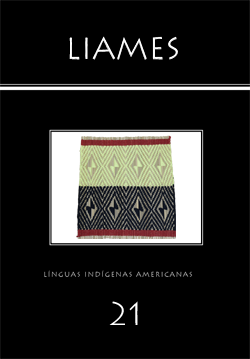Abstract
The main objective of this article is to describe the basic morphosyntactic properties that make it possible to distinguish between mass and count nouns in the Wa’ikhana language (Eastern Tukanoan). The discussion, circumscribed to the level of the noun phrase, focuses on three points: the grammatical number, quantifiers and the use of numerals as nominal modifiers. As will be shown, mass nouns are distinguished from count ones in that they do not receive plural number suffixes and do not occur in constructions with numerals. On the other hand, the mass nouns can be individuated and receive a count reading when combined with a classifying suffix or with the suffix -do ‘3npl’. The distribution of quantifiers divides inanimate nouns into 1) count and mass ones that denote objects and 2) mass ones that denote granular and liquid substances. In addition to the discussion of count and mass nouns, the article provides a description of the Wa’ikhana numeral system, addressing its extension, the degree of its conventionalization and the interaction between numerals and grammatical number.
References
Balykova, Kristina (2019). What do oranges and hammers have in common? The classifier ‘round’ in Wa’ikhana and other East Tukano languages. LIAMES. Línguas Indígenas Americanas 19: 1-24, e019013. https://doi.org/10.20396/liames.v19i0.8655262
Barnes, Janet; Malone, Terrell (2000). El Tuyuca. In M. S. G. de Pérez e M. L. R. de Montes (eds.), Lenguas de Colombia: Una visión descriptiva, pp. 437-452. Bogotá: Instituto Caro y Cuervo.
Chierchia, Gennaro (2009). Mass nouns, vagueness and semantic variation. Synthese 174: 99-149.
De Pérez, María Stella González (2000). Bases para el estudio de la lengua Pisamira. In M. S. G. de Pérez and M. L. R. de Montes (eds.), Lenguas de Colombia: Una visión descriptiva, pp. 373-393. Bogotá: Instituto Caro y Cuervo.
Erbaugh, Mary S. (2006). Chinese classifiers: Their use and acquisition. In Ping Li, Li Hai Tan, Eliz-abeth Bates, e Ovid J.L. Tzeng (eds.), Handbook of East Asian Psycholinguistics: Chinese, pp. 39-51. Cambridge: Cambridge University Press.
Gomez-Imbert, Elsa (1982). De la forme et du sense dans la classification nominale en Tatuyo (Langue Tukano Orientale d’Amazonie Colombienne) (Tese de doutorado em linguística). Paris: Université Sorbonne – Paris IV.
Gomez-Imbert, Elsa (2007). Nominal classification in Tukanoan languages. In: W. L. Wetzels (ed.), Language endangerment and endangered languages: Linguistic and anthropological studies with special emphasis on the languages and cultures of the Andean-Amazonian border area, pp. 401-428, Leiden: Leiden University.
IBGE – Instituto Brasileiro de Geografia e Estatística (2010). Censo demográfico 2010. Características gerais dos indígenas. Resultados do universo. Rio de Janeiro: IBGE.
Jackendoff, Ray (1991). Parts and boundaries. Cognition 41(1-3): 9-45.
Jones, Wendell; Jones, Paula (1991). Barasano syntax: Studies in the languages of Colombia 2. Dallas: The Summer Institute of Linguistics and The University of Texas at Arlington.
Kinch, Rodney; Kinch, Pamela (2000). El Yurutí. In M. S. G. de Pérez and M. L. R. de Montes (eds.), Lenguas de Colombia: Una visión descriptiva, pp. 469-487. Bogotá: Instituto Caro y Cuervo.
Lima, Suzi; Rothstein, Susan (2020). A typology of the mass/count distinction in Brazil and its rele-vance for mass/count theories. Linguistic Variation 20(2): 174-218. https://doi.org/10.1075/lv.00015.lim
Metzger, Ronald G. (2000). Marĩ yaye mena carapana, yaia yaye mena español macãrĩcã tuti (carapana – español, diccionario de 1000 palabras). Santafé de Bogotá: Editorial Buena Semilla.
Ramirez, Henri (1997). A fala Tukano dos Ye’pâ-Masa. Tomo 1. Gramática. Manaus: Inspetoria Salesiana Missionária da Amazônia, CEDEM.
Silva, Wilson de Lima (2012). A descriptive grammar of Desano (Tese de doutorado em linguística). Salt Lake City: University of Utah. https://collections.lib.utah.edu/ark:/87278/s6s5016g
Smothermon, Jeffrey R.; Smothermon, Josephine H.; Frank, Paul S. (1995). Bosquejo del Macuna. Santafé de Bogotá: Associación Instituto Lingüístico de Verano.
Stenzel, Kristine (2013). A reference grammar of Kotiria (Wanano). Lincoln: University of Nebraska Press.
Waltz, Carolyn H.; Waltz Nathan E. (2015). Una gramática pedagógica del Piratapuyo. https://www.sil.org/resources/archives/63416
Waltz, Nathan E. (2012). Diccionario bilingüe: Piratapuyo – Español, Español – Piratapuyo. https://www.sil.org/resources/archives/51925

This work is licensed under a Creative Commons Attribution-NonCommercial 4.0 International License.
Copyright (c) 2021 Kristina Balykova


